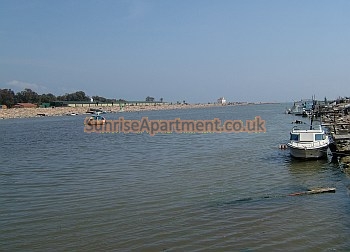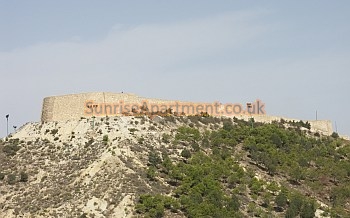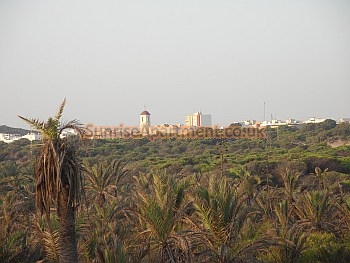A Brief History of the Origins of Guardamar del Segura
 Guardamar when translated literally means guardian of the sea. It's prime location, situated at the mouth of the river Segura has meant that the town of Guardamar del Segura has been popular throughout the ages with the many different cultures who at one point or another have invaded this part of Spain and settled here.
Guardamar when translated literally means guardian of the sea. It's prime location, situated at the mouth of the river Segura has meant that the town of Guardamar del Segura has been popular throughout the ages with the many different cultures who at one point or another have invaded this part of Spain and settled here.
Iberians, Phoenicians, Greeks, Romans and Arabs have all settled in the area in differing degrees because it's location on the Segura meant that seafaring vessels have always been able to penetrate the mainland. However, Guardamar has always taken advantages of the adversities that have befallen it.
Also because of it's close proximity it has meant that it has always been an important lookout point and so became the site of various ancient fortifications. When a terrible earthquake struck in 1829 destroying the old walled city and the castle at its centre, the surviving inhabitants were forced to search for a new location closer to the shore and Guardamar as we know it today began it's life.
The Ancient Remains At Guardamar del Segura
 As years faded into decades and decades to centuries, many of the ancient remains of Guardamar del Segura have been lost by the passage of time, however not all are gone and forgotten.
As years faded into decades and decades to centuries, many of the ancient remains of Guardamar del Segura have been lost by the passage of time, however not all are gone and forgotten.
One important site that still remains and can be seen looming over the town is the Guardamar castle. Dating back to between the 9th and 10th centuries Guardamar castle is unique to the west and has been declared a site of cultural interest.
There was an important archaeological discovery made on the Iberian site of Cabezˇ Lucero; this discovery was the unearthing of a bust of a woman. The bust, which has aptly been called the "Dame of Guardamar", is very similar to the other famous bust know as the "Dame of Elche" which was also discovered in this area of the Costa Blanca.
Set amidst las dunas de Guardamar is another site of archaeological importance which dates back to the Arab times, it is the mosque of the Caliphate Rabita. If you are interested in finding out more about the history of Guardamar then the centrally located Casa de Cultura (House of Culture) is the home to many important artefacts that go a way to explaining much of Guardamar del Segura's interesting history.
Guardamar del Segura, las Dunas de Guardamar & the Beaches of Guardamar
 As mentioned previously, the earthquake of 1829 drove the inhabitants closer to the shore of the beautiful beaches that stretch along this section of the Costa Blanca; however this presented Guardamar with some major problems, the solution for which has shaped Guardamar del Segura as we know it today.
As mentioned previously, the earthquake of 1829 drove the inhabitants closer to the shore of the beautiful beaches that stretch along this section of the Costa Blanca; however this presented Guardamar with some major problems, the solution for which has shaped Guardamar del Segura as we know it today.
Along this section of the coast, strong winds created what were called the "flying sands" this caused the coastal dunes to advance significantly which began burying the town in the fine golden sand of the white coast. It became imperative that a solution could be found to rectify this problem and by the end of the 19th century a solution was found.
The resolution to this major problem was completed over a 30 year period (1900-1930) and required that a large area of the dunes separating the town from the sea be planted with a variety of trees forming a forest along the dunes to prevent further damage to the town. This strategy was successful, and the advancing sands halted.
The forest is very much part of the heritage and beauty of Guardamar del Segura and includes the beautiful parks of Parque Alfonso XIII and Parque Reina Sofia. "Las dunas de Guardamar" cover an area of 840 hectares and are as important today as they ever were. They consist palms, pines, cypresses and eucalyptus trees and have been declared an area of natural interest. The regeneration of the dunes still is as strong today and they are often being replanted and protected.
Within Guardamar's natural parks you will find an abundance of variety both in plants, trees, birds and animals. Amongst these you will find Red Squirrels, Peacocks, Black Swans and many more. The natural park is a fabulous place for an afternoon stroll to take in the beauty of the natural landscape.
Those same beaches that the town had to be protected from are what draws an abundance of tourists to Guardamar every year. There are 14 kilometres of fabulous beaches at Guardamar, each with fine, golden sands. In total Guardamar del Segura has eight of its very own beaches including cosmopolitan blue flag beaches, nudist beaches and beaches which remain in their natural state.
From the North of Guardamar to the south, the beaches are Los Tusales (the naturist beach) , Los Viveros (the beach near the Sunrise Apartment), De la Babil˛nia, Playa Centro, La Roqueta, El Monacayo, Playa del Campo and Les Ortigues.
Each of these fabulous beaches has soft, warm high quality sand along the full length and the backdrop of dunes planted with pines and palm trees. The beaches in Guardamar are absolutely beautiful and they have plenty of room for everyone to find their very own space.

